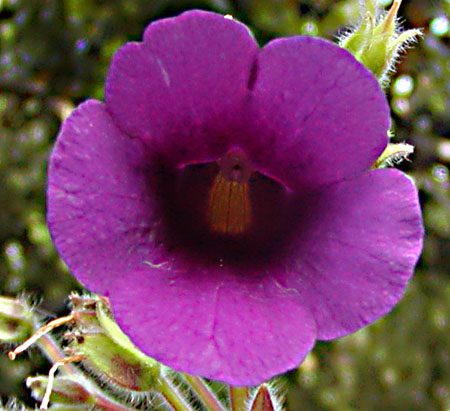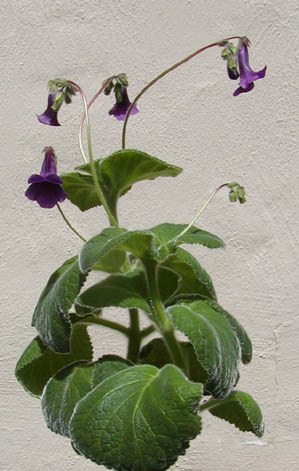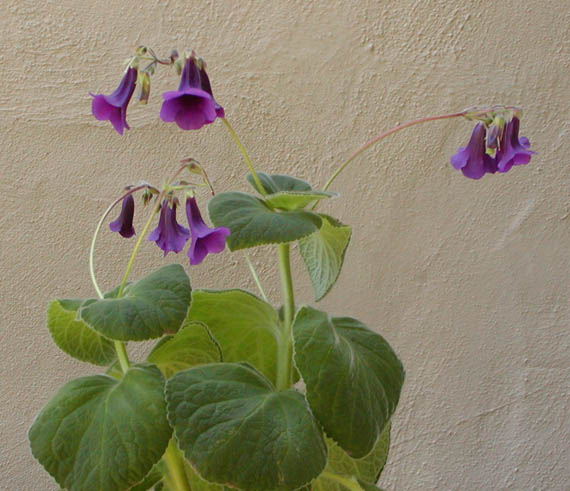- Description
- Comparison to S. aghensis (link)
- Horticulture
- In habitat
- Hybridization
- Feature table
- Publication
This relatively new species has very handsome flowers, quite large for a sinningia, held well above the leaves for maximum exposure.

| Species list |
Hybrids list |
Tubers list |
Topics list |
Site index |
What's new |
Home page |
This species, which had the holding name of Sinningia sp. "Ibitioca", has now (2015) been named S. bragae, in honor of its discoverer Joćo Marcelo Braga.
This relatively new species has very handsome flowers, quite large for a sinningia, held well above the leaves for maximum exposure. |

|

|
DescriptionThis species strongly resembles Sinningia aghensis in having dark, somewhat hairy leaves, with flowers borne on an extended peduncle. The flowers are purple and campanulate. The peduncle is longer than that of Sinningia aghensis, and there are usually three or more leaf pairs. This picture shows Sinningia bragae in bloom in May 2006. Compared to S. aghensisSee a comparison between the two species. |
HorticultureUnfortunately, this handsome species is not so easy to grow well. It has a couple drawbacks. Cold. It is more sensitive to cold than most sinningia species. This is a trait it shares with its relative S. aghensis. Cold which would not bother most sinningia tubers (around 32 F = 0 C) tends to kill dormant tubers of this species. This means that tubers must be kept indoors during winter. Flowering. It is not so easy to get it to bloom. It appears to need lots of light and heat, but does not tolerate drying out very well. One good quality I discovered when I took the plant to a local club meeting. The peduncles swung and swayed with every turn of the car and every bump in the road, during a trip 35 miles each direction, but not one of the flowers fell off. The pedicels appear to hold their flowers very firmly. (At the meeting, I demonstrated this by shaking the plant.) |

|
In habitatAccording to the article by Tsuh Yang Chen in The Gloxinian, vol. 55, No. 1 (first quarter 2005), this species was first found in 1993 near the town of Ibitioca in the interior of Rio de Janeiro province of Brazil. Tsuh Yang Chen and Mario Peixoto found it again in 2001, growing in full sun in niches on the side of a steep cliff. HybridizationBill Price crossed this species with Sinningia eumorpha. When grown well, the resulting hybrid, which he named S. 'Altamont Cascade', is a very striking plant. Unfortunately, it seems to have some of the same problems as Sinningia bragae. Mine is erratic about blooming. It is also less tolerant of cold than Sinningia eumorpha, but more so than Sinningia bragae. This species has also been crossed with Sinningia pusilla. Dave Zaitlin crossed this species with its close relative S. aghensis and obtained viable seed. He generously gave me some seeds, and they germinated quite promptly. For both of us, the seedlings grew very slowly and remained small. After a couple years, they did not come out of dormancy. We don't know what went wrong. |
| Plant Description |
|
| Growth | Indeterminate |
| Habit | Upright stems |
| Leaves | Green |
| Dormancy | Stems not necessarily deciduous |
Flowering |
|
| Inflorescence | axillary cyme. Base of the peduncle is green; top is dark red. |
| Season | Blooms in early summer |
| Flower | Purple, with yellow stripe deep in throat. Purple streaks lengthwise on stripe. The calyx is the same dark red as the peduncle top. |
Horticultural aspects |
|
| Hardiness | Can tolerate approx. 38-40 F (about 4 C), but not a freeze. See discussion above. |
| Recommended? | With reservations. Large, glossy flowers are a big plus. Still, there are longevity issues. Not a compact grower, it should also be mentioned... |
Hybridization |
|
| Hybrids with this species | See listing. |
Botany |
|
| Taxonomic group | The aghensis group of the Corytholoma clade. |
| Nectaries | Five, separate |
By Chautems, Peixoto & Rossini 2015.